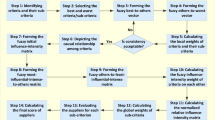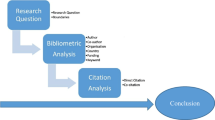Abstract
This paper proposes a consensus-trust driven framework of bidirectional interaction for social network large-group decision making. Firstly, the concepts of interaction consensus threshold and interaction trust threshold are defined, which are used to discriminate the interaction modes between subgroups into four categories. Corresponding hybrid feedback strategies are designed in which the consensus level and trust level of subgroups are regarded as reliable resources to facilitate the achievement of group consensus. Secondly, a minimum adjustment bidirectional feedback model considering cohesion is developed to help the interacting subgroups reach mutual consensus with minimum opinion modification. Finally, the proposed consensus framework is applied to a blockchain platform selection problem in supply chain to demonstrate the effectiveness and applicability of the model.






Similar content being viewed by others
References
Bai CG, Zhu QY, Sarkis J (2021) Joint blockchain service vendor-platform selection using social network relationships: a multi-provider multi-user decision perspective. Int J Prod Econ 238:108165
Bergstrom CT, Bak-Coleman JB (2019) Gerrymandering in social networks. Nature 573(7772):40–41
Cao MS, Wu J, Chiclana F, Ureña R, Herrera-Viedma E (2021) A personalized consensus feedback mechanism based on maximum harmony degree. IEEE Trans Syst Man Cybern Syst 51(10):6134–6146
Cao MS, Wu J, Chiclana F, Herrera-Viedma E (2021) A bidirectional feedback mechanism for balancing group consensus and individual harmony in group decision making. Inf Fusion 76:133–144
Cao MS, Liu YJ, Gai TT, Zhou M, Fujita H, Wu J (2022) A comprehensive star rating approach for cruise ships based on interactive group decision making with personalized individual semantics. J Mar Sci Eng 10:1–20
Chao XR, Kou G, Peng Y, Herrera-Viedma E, Herrera F (2021) An efficient consensus reaching framework for large-scale social network group decision making and its application in urban resettlement. Inf Sci 575:499–527
Chen XH, Zhang WW, Xu XH, Cao WZ (2022) Managing group confidence and consensus in intuitionistic fuzzy large group decision-making based on social media data mining. Group Decis Negot. https://doi.org/10.1007/s10726-022-09787-w
Cheng D, Yuan YX, Wu Y, Hao TT, Cheng FX (2022) Maximum satisfaction consensus with budget constraints considering individual tolerance and compromise limit behaviors. Eur J Oper Res 297(1):221–238
Dong QX, Cooper O (2016) A peer-to-peer dynamic adaptive consensus reaching model for the group AHP decision making. Eur J Oper Res 250(2):21–530
Dong QX, Sheng Q, Martínez L, Zhang Z (2022) An adaptive group decision making framework: individual and local world opinion based opinion dynamics. Inf Fusion 78:218–231
Dong YC, Xu YF, Yu S (2009) Computing the numerical scale of the linguistic term set for the 2-tuple fuzzy linguistic representation model. IEEE Trans Fuzzy Syst 17(6):1366–1378
Du ZJ, Yu SM, Luo HY, Lin XD (2021) Consensus convergence in large-group social network environment: coordination between trust relationship and opinion similarity. Knowl Based Syst 217:106828
Farshidi S, Jansen S, España S, Verkleij J (2020) Decision support for blockchain platform selection: three industry case studies. IEEE Trans Eng Manag 67(4):1109–1128
Gao Y, Zhang Z (2022) Consensus reaching with non-cooperative behavior management for personalized individual semantics-based social network group decision making. J Oper Res Soc. https://doi.org/10.1080/01605682.2021.1997654
Gong ZW, Guo WW, Slowiński R (2021) Transaction and interaction behavior-based consensus model and its application to optimal carbon emission reduction. Omega 104:102491
Herrera F, Martínez L (2000) A 2-tuple fuzzy linguistic representation model for computing with words. IEEE Trans Fuzzy Syst 8(6):746–752
Hou FJ, Triantaphyllou E (2019) An iterative approach for achieving consensus when ranking a finite set of alternatives by a group of experts. Eur J Oper Res 275(2):570–579
Kamis NH, Chiclana F, Levesley J (2019) An influence-driven feedback system for preference similarity network clustering based consensus group decision making model. Inf Fusion 52:257–267
Labella Á, Liu Y, Rodríguez RM, Martínez L (2018) Analyzing the performance of classical consensus models in large scale group decision making: a comparative study. Appl Soft Comput 67:677–690
Labella A, Rodriguez RM, De Tre G, Martinez L (2019) A cohesion measure for improving the weighting of experts subgroups in large-scale group decision making clustering methods. 2019 IEEE international conference on fuzzy systems (FUZZ-IEEE), 1-6. 10.1109/FUZZ-IEEE.2019.8858858
Lai H, Liao HC (2021) A multi-criteria decision making method based on DNMA and CRITIC with linguistic D numbers for blockchain platform evaluation. Eng Appl Artif Intell 101:104200
Li CC, Rodríguez RM, Martínez L, Dong YC, Herrera F (2018) Personalized individual semantics based on consistency in hesitant linguistic group decision making with comparative linguistic expressions. Knowl Based Syst 145:156–165
Li CC, Dong YC, Herrera F (2019) A consensus model for large-scale linguistic group decision making with a feedback recommendation based on clustered personalized individual semantics and opposing consensus group. IEEE Trans Fuzzy Syst 27(2):221–233
Li SL, Rodríguez RM, Wei CP (2021) Managing manipulative and non-cooperative behaviors in large scale group decision making based on a WeChat-like interaction network. Inf Fusion 75:1–15
Li YH, Kou G, Li GX, Yi P (2022) Consensus reaching process in large-scale group decision making based on bounded confidence and social network. Eur J Oper Res 303(2):790–802
Liu BS, Zhou Q, Ding RX, Palomares I, Herrera F (2019) Large-scale group decision making model based on social network analysis: trust relationship-based conflict detection and elimination. Eur J Oper Res 275(2):737–754
Liu BS, Jiao SX, Shen YH, Chen Y, Wu GB, Chen S (2022) A dynamic hybrid trust network-based dual-path feedback consensus model for multi-attribute group decision-making in intuitionistic fuzzy environment. Inf Fusion 80:266–281
Liu WQ, Zhang HJ, Liang HM, Li CC, Dong YC (2022) Managing consistency and consensus issues in group decision-making with self-confident additive preference relations and without feedback: a nonlinear optimization method. Gr Decis Negot 31:213–240
Lu YL, Xu YJ, Huang J, Wei J, Herrera-Viedma E (2022) Social network clustering and consensus-based distrust behaviors management for large-scale group decision-making with incomplete hesitant fuzzy preference relations. Appl Soft Comput 117:108373
Martínez L, Herrera F (2012) An overview on the 2-tuple linguistic model for computing with words in decision making: extensions, applications and challenges. Inf Sci 207:1–18
Pan XH, Wang YM, He SF, Chin K-S (2022) A dynamic programming algorithm based clustering model and its application to interval type-2 fuzzy large-scale group decision-making problem. IEEE Trans Fuzzy Syst 30(1):108–120
Pérez IJ, Cabrerizo FJ, Alonso S, Herrera-Viedma E (2014) A new consensus model for group decision making problems with non-homogeneous experts. IEEE Trans Syst Man Cybern Syst 44(4):494–498
Qin JD, Li MX, Liang YY (2022) Minimum cost consensus model for CRP-driven preference optimization analysis in large-scale group decision making using Louvain algorithm. Inf Fusion 80:121–136
Rodríguez RM, Labella Á, Sesma-Sara M, Bustince H, Martínez L (2021) A cohesion-driven consensus reaching process for large scale group decision making under a hesitant fuzzy linguistic term sets environment. Comput Ind Eng 155:107158
Sun Q, Wu J, Chiclana F, Fujita H, Herrera-Viedma E (2022) A dynamic feedback mechanism with attitudinal consensus threshold for minimum adjustment cost in group decision making. IEEE Trans Fuzzy Syst 30:1287–1301
Tang M, Liao HC, Herrera-Viedma E, Chen CLP, Pedrycz W (2021) A dynamic adaptive subgroup-to-subgroup compatibility-based conflict detection and resolution model for multicriteria large-scale group decision making. IEEE Trans Cybern 51(10):4784–4795
Wan QF, Xu XH, Chen XH, Zhuang J (2020) A two-stage optimization model for large-scale group decision-making in disaster management: minimizing group conflict and maximizing individual satisfaction. Gr Decis Negot 29:901–921
Wang S, Wu J, Chiclana F, Sun Q, Herrera-Viedma E (2022) Two stage feedback mechanism with different power structures for consensus in large-scale group decision-making. IEEE Trans Fuzzy Syst. https://doi.org/10.1109/TFUZZ.2022.3144536
Wasserman S, Faust K (1994) Social network analysis: methods and applications, vol 8. Cambridge University Press, Cambridge
Wu J, Chiclana F (2014) A social network analysis trust-consensus based approach to group decision-making problems with interval-valued fuzzy reciprocal preference relations. Knowl Based Syst 59:97–107
Wu J, Chiclana F, Herrera-Viedma E (2015) Trust based consensus model for social network in an incomplete linguistic information context. Appl Soft Comput 35:827–839
Wu J, Chiclana F, Fujita H, Herrera-Viedma E (2017) A visual interaction consensus model for social network group decision making with trust propagation. Knowl Based Syst 39:39–50
Wu J, Cao MS, Chiclana F, Dong YC, Herrera-Viedma E (2021) An optimal feedback model to prevent manipulation behaviour in consensus under social network group decision making. IEEE Trans Fuzzy Syst 29(7):1750–1763
Wu J, Chen J, Liu W, Liu YJ, Liang CY, Cao MS (2022) A calibrated individual semantic based failure mode and effect analysis and its application in industrial internet platform. Mathematics 10:2492
Wu J, Wang S, Chiclana F, Herrera-Viedma E (2021) Two-fold personalized feedback mechanism for social network consensus by uninorm interval trust propagation. IEEE Trans Cybern. https://doi.org/10.1109/TCYB.2021.3076420
Wu T, Liu XW, Qin JD, Herrera F (2021) Balance dynamic clustering analysis and consensus reaching process with consensus evolution networks in large-scale group decision making. IEEE Trans Fuzzy Syst 29(2):357–371
Wu ZB, Tu JC (2021) Managing transitivity and consistency of preferences in AHP group decision making based on minimum modifications. Inf Fusion 67:125–135
Xing YM, Cao MS, Liu YJ, Zhou M, Wu J (2022) A choquet integral based interval type-2 trapezoidal fuzzy multiple attribute group decision making for sustainable supplier selection. Comput Ind Eng 165:107935
Xu WJ, Chen X, Dong YC, Chiclana F (2021) Impact of decision rules and non-cooperative behaviors on minimum consensus cost in group decision making. Gr Decis Negot 30:1239–1260
Xu XH, Zhang QH, Chen XH (2020) Consensus-based non-cooperative behaviors management in large-group emergency decision-making considering experts’ trust relations and preference risks. Knowl Based Syst 190:105108
Yu SM, Du ZJ, Zhang XY, Luo HY, Lin XD (2021) Punishment-driven consensus reaching model in social network large-scale decision-making with application to social capital selection. Appl Soft Comput Part A 113:107912
Yu SM, Du ZJ, Zhang XY, Luo HY, Lin XD (2021) Trust cop-kmeans clustering analysis and minimum-cost consensus model considering voluntary trust loss in social network large-scale decision-making. IEEE Trans Fuzzy Syst 30(7):2634–2648
Yu WY, Zhang Z, Zhong QY (2021) Consensus reaching for MAGDM with multi-granular hesitant fuzzy linguistic term sets: a minimum adjustment-based approach. Ann Oper Res 300(2):443–466
Yuan YX, Cheng D, Zhou ZL (2021) A minimum adjustment consensus framework with compromise limits for social network group decision making under incomplete information. Inf Sci 549:249–268
Zhang LL, Yuan JJ, Gao XY, Jiang DW (2021) Public transportation development decision-making under public participation: a large-scale group decision-making method based on fuzzy preference relations. Technol Forecast Soc Change 172:121020
Zhang Z, Li ZL (2021) Personalized individual semantics-based consistency control and consensus reaching in linguistic group decision making. IEEE Trans Syst Man Cybern Syst. https://doi.org/10.1109/TSMC.2021.3129510
Acknowledgements
This work was supported by the National Natural Science Foundation of China (NSFC) (No. 71971135, 71971039 and 71910107002), Top-notch innovative program of Shanghai Maritime University (No. 2021YBR006), China Scholarship Council (No.202108310183)Shanghai Foreign Experts Program(22WZ2506100), project PID2019-103880RB-I00 funded by MCIN / AEI / 10.13039/501100011033 and by the Andalusian Government through the project P2000673.
Author information
Authors and Affiliations
Corresponding author
Additional information
Publisher's Note
Springer Nature remains neutral with regard to jurisdictional claims in published maps and institutional affiliations.
Rights and permissions
Springer Nature or its licensor holds exclusive rights to this article under a publishing agreement with the author(s) or other rightsholder(s); author self-archiving of the accepted manuscript version of this article is solely governed by the terms of such publishing agreement and applicable law.
About this article
Cite this article
Gai, T., Cao, M., Chiclana, F. et al. Consensus-trust Driven Bidirectional Feedback Mechanism for Improving Consensus in Social Network Large-group Decision Making. Group Decis Negot 32, 45–74 (2023). https://doi.org/10.1007/s10726-022-09798-7
Accepted:
Published:
Issue Date:
DOI: https://doi.org/10.1007/s10726-022-09798-7




